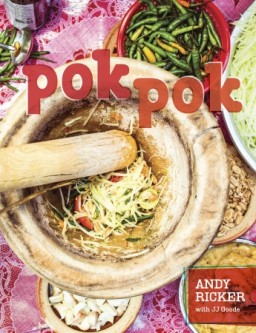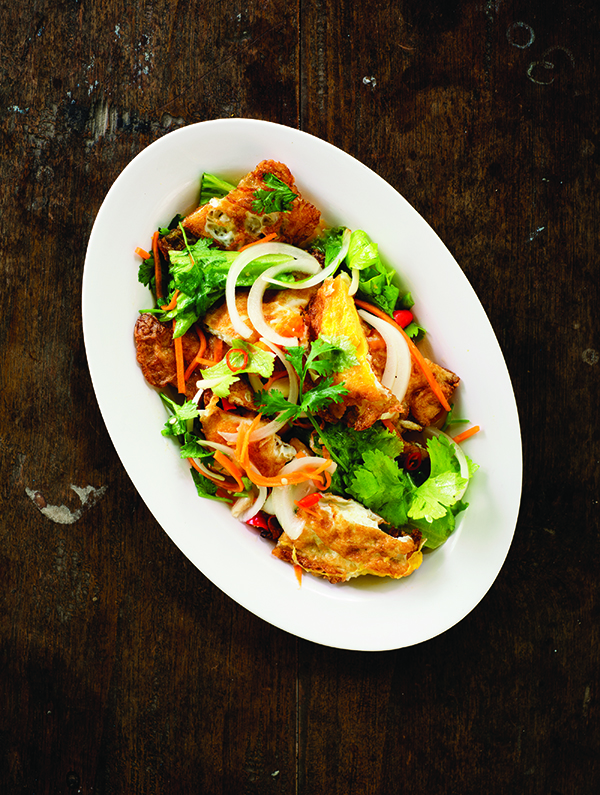J.J. Goode and I go back a long, long way.. ten years, at least. We both started out on eGullet, writing about our love of food. I have long admired him and his work. When I heard he had a new book, Pok Pok: Food and Stories from the Streets, Homes, and Roadside Restaurants of Thailand, I was thrilled. And after reading a review copy, I must say that the man has outdone himself. It is a book about real food, real people and truly terrific flavors. I asked him if he would tell us a bit about the book in his own words….
Behind the Book: Pok Pok
By J.J. Goode
Hi, everyone! I’m thrilled that Monica asked me to share a recipe from a book I co-authored called Pok Pok: Food and Stories from the Streets, Homes, and Roadside Restaurants of Thailand, which released on October 29.
Yam Khai Dao
Fried egg salad
“Reprinted with permission from Pok Pok by Andy Ricker with J.J. Goode, copyright © 2013. Published by Ten Speed Press, a division of Random House, Inc.”
Photography credit: Austin Bush © 2013
Serves 2 to 6 as part of a meal; the recipe is easily doubled
EGGS
2 large eggs, at room temperature
1/4 to 1/3 cup vegetable oil
DRESSING
11/2 tablespoons lime juice (preferably from Key limes or spiked with a small squeeze of Meyer lemon juice)
11/2 tablespoons Naam Cheuam Naam Taan Piip (Palm sugar simple syrup)
1 tablespoon Thai fish sauce
3 grams peeled garlic, halved lengthwise and very thinly sliced (about 11/2 teaspoons)
2 grams fresh Thai chiles (about 2 small), preferably green, thinly sliced
SALAD
14 grams green leaf lettuce, cut into 2-inch-thick pieces (about 1 cup, lightly packed)
1 ounce peeled yellow onion, thinly sliced with the grain (about 1/4 cup, lightly packed)
14 grams peeled carrot, cut into long (about 3-inch), thin (about 1/8-inch) strips (about 1/4 cup, lightly packed)
1/4 cup very coarsely chopped Chinese celery (thin stems and leaves), lightly packed
1/4 cup very coarsely chopped cilantro (thin stems and leaves), lightly packed
FRY THE EGGS
Heat a wok or nonstick frying pan over high heat, then add just enough oil to reach a depth of a generous 1/4 inch. Once the oil begins to smoke, carefully crack in the eggs (holding them close to the oil to avoid splatter) and decrease the heat to medium. The eggs should spit, bubble, and crackle wildly. The whites should puff and develop large transparent bubbles.
Once the whites get crispy and deep golden brown at the edges, 45 seconds to 1 minute, use a spatula to flip the eggs (try not to break the yolks, but if you do,it’s fine) and keep cooking until the bottom is golden brown and the yolks are set but still molten, 30 to 45 seconds more. Transfer the eggs to paper towels to drain. Discard the oil, then rinse and wipe out the wok and let it cool. You can fry the eggs up to 15 minutes or so before you make the salad.
MAKE THE DRESSING AND ASSEMBLE THE SALAD
Add the lime juice, simple syrup, fish sauce, garlic, and chiles to the wok, set it over medium heat, and heat the mixture just until it’s warm to the touch, 15 seconds or so. Turn off the heat.
Quarter the eggs through the yolks and add them to the wok along with the remaining ingredients. Stir gently but well, then transfer the salad, liquid and all, to a plate in a low heap, so that most of the herbs end up near the top, and serve.
Subrecipe: Naam Cheuam Naam Taan Piip (Palm sugar simp le syrup)
Some recipes call for a dead-simple syrup made from palm sugar and water. You can easily double or quadruple the amounts.
Makes about 1/2 cup
21/2 ounces palm sugar, coarsely chopped
1/4 cup plus 1 tablespoon water
Combine the sugar and the water in a very small pot or pan. Set it over medium heat and cook, stirring and breaking up the sugar as it softens, just until the sugar has completely dissolved. If the water begins to bubble before the sugar has completely dissolved, turn off the heat and let it finish dissolving in the hot liquid. Let it cool before storing. The syrup keeps in an airtight container in the fridge for up to 2 weeks.
**** BUY NOW ****




